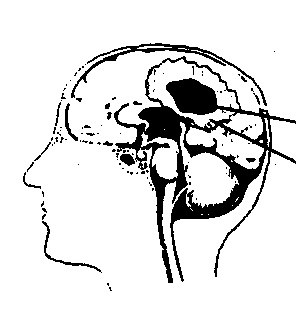
.
Area of dead tissue
Ischemic Penumbra where blood
vessels are damaged and blood
flow is reduced enough to disrupt
the function of nerve cells, but
not enough to kill them.
The majority of strokes are caused by blood vessel obstructions, such as blood clots, that cut off blood and oxygen to parts of the brain. This results in the death of nerve cells within a few minutes if their blood flow is reduced to less than 10% of normal. These dying brain cells begin to swell due to their cell walls breaking down, allowing water to move into the cells. As these cells swell, they begin to expand into the surrounding tissues. This causes constriction of the blood vessels in the surrounding tissues which then causes a lack of oxygen to these previously normal cells. These surrounding cells then begin to swell as well. This gradually increasing, damaged, hypoxic tissue surrounding the original injury is called the "ischemic penumbra," and contributes up to 85% of the disability resulting from a stroke. The cells in this secondary area have the potential of being restored to normal or near-normal function.
In 1934, the neuroscientist Dr. Cyril B. Courville wrote, "crippled nerve cells may persist in the margins of wounds of the brain for many years." [Archives of Pathology, 2934, 17(1): 10-21]. In 1981, Astrup, Siesjo and Symon suggested that within these damaged margins, idling neurons are present, are metabolically lethargic and are non-functional--but remain viable because of low oxygen levels [Stroke, 1981; 12: 723-25].
The ultimate proof of this dormant life was with the use of SPECT brain scans done before and after a course of hyperbaric oxygen treatments [Lancet, March 3, 1990: 542]. These studies by Dr. Richard Neubauer conclusively demonstrated the development of new blood vessels to the rim of tissue surrounding the area of the brain that had been damaged. The newly formed blood vessels resulting from the hyperbaric oxygen therapy can then bring fresh blood (oxygen) and nutrients to the damaged tissue. The tissue begins to repair itself and returns to normal or near-normal. These "resurrected" neurons gradually reconnect to the rest of the brain. These revived neurons and their connections help to return the use of lost cerebral and bodily functions.
Hyperbaric oxygen does not resurrect dead brain tissue, but it does assist the wound healing capabilities in the brain just as it helps wound healing in other parts of the body that lack oxygenation.

|
. . Area of dead tissue Ischemic Penumbra where blood vessels are damaged and blood flow is reduced enough to disrupt the function of nerve cells, but not enough to kill them. |
Hyperbaric oxygen (HBO) is 100% oxygen under pressure. The patient is placed in a sealed chamber and breathes oxygen through a mask as the pressure is gradually increased. At normal pressure and normal living conditions, oxygen is carried almost exclusively in the red blood cells. When 100% oxygen is under pressure, it is dissolved into the red blood cells and into all body fluids including the brain's extracellular fluids.
Dr. Steenblock uses HBO at 1.5 Atmospheres Pressure (ATA) in his therapy. This means that there is an 8- to 9-fold increase in oxygen delivered to the capillaries compared to breathing normal air. The main mechanism of action of HBO in stroke is the rehabilitation of the ischemic penumbra. The therapy relieves ischemia/hypoxia, reduces brain edema, restores the integrity of the cell membranes, neutralizes toxic amines, enhances immune defenses, and renews dormant, ischemic neurons. With high pressure, the oxygen can reach areas where the blood flow and oxygen supply are restricted. This increased oxygen helps initiate cell repair processes.
In addition, HBO induces new blood vessel growth, such that new capillaries begin to supply the oxygen and nutrients needed to restore dormant nerve cells. Thus hyperbaric oxygen therapy revives tissue that has not functioned since the stroke, which in some cases occurred 10 to 15 years earlier.
In 1971 Dr. George Hart published a case study of hyperbaric oxygen treatment in a Naval Officer who was partially paralyzed from a stroke. There was good improvement after 15 HBO sessions. This was followed by a month with no HBO. During that month, there was no change in the patient's condition. After the next series of treatments, the officer was able to return to full duty.
Dr. Hart then used hyperbaric oxygen therapy on 40 patients with cerebral ischemia. Thirty-three of these patients showed measurable neurologic improvement. In 1976, Dr. Holbach used HBO with forty patients aged 8 to 68 years who had suffered a stroke. With HBO, 27% showed significant improvement, 53% showed moderate improvement, and 20% showed no improvement. Dr. Jain found that HBO significantly reduced spasticity in all 21 stroke patients studied, especially when physical therapy was done inside the hyperbaric chamber. Dr. Neubauer and Dr. Steenblock have seen improvement in stroke patients who have been paralyzed for as long as 15 years.
If a physician is using ASME/PVHO certified or their equivalent HBO tanks with certified technician support, the dangers of HBO are minimal. Generally, the only problem a person has is ear pain during the compression and decompression, which is comparable to what occurs during changes in altitude in a plane. However, if the pressure is raised and lowered slowly, even this problem is reduced.
Since oxygen is the most natural drug there is and cannot be exploited by the pharmaceutical industry, HBO use is more prevalent in other countries. Today, Russia has over 2,000 hyperbaric chambers and China has more. The United States has a total of 300 chambers, six of which are Hyox chambers at Dr. Steenblock's clinic.
In addition to hyperbaric oxygen, Dr. Steenblock's holistic treatment of stroke includes physical therapy, EEG biofeedback, functional electrical stimulation, dietary counseling, and hormonal and nutritional therapies when needed.